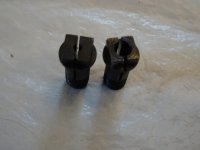Hello everyone,
New to the forum but I’ve surfed a little over the years. I owned a large fab shop for years but I’m out of that now and purchased some older machines I’m trying to teach myself to use so I’ll be quite active here now. I’m a really fast learner but please excuse my potential ignorance here in the beginning.
My question is about a tapping head. I purchased an old Hardinge AHC and a DV-59 for a project I’m trying to start up. I’ll be mass producing small titanium body jewelry for a friend and I need to tap 000-120 and M1.2 threads in the end of the posts. I will be running a tapping head in both machines because the AHC will turn, drill, tap, and part off so the other end of the piece will be run on the DV-59.
Problem is I didn’t really research capacities of tapping heads before I got this far. Ive searched specs on every tapping head I find used until I turned blue and I never found anything that went down to 000. The closest thing I found was a tapmatic N/C-R00 and it only goes down to M1 which is so close but out of spec for me. I’m hoping someone here can tell me about a tapping head I can search for or to go with where I’m at now which is just try the tapmatic N/C-R00 and see what happens.
I’m asking for advise because I’m trying to hunt down used tapping heads at first to get the project off the ground. Once this is up and running smoothly I can probably justify a nice CNC Swiss machine to take over with fancy new tooling.
If anyone has some input please let me know. I really appreciate anything at all that can help get this up and running already. Thanks in advance!
New to the forum but I’ve surfed a little over the years. I owned a large fab shop for years but I’m out of that now and purchased some older machines I’m trying to teach myself to use so I’ll be quite active here now. I’m a really fast learner but please excuse my potential ignorance here in the beginning.
My question is about a tapping head. I purchased an old Hardinge AHC and a DV-59 for a project I’m trying to start up. I’ll be mass producing small titanium body jewelry for a friend and I need to tap 000-120 and M1.2 threads in the end of the posts. I will be running a tapping head in both machines because the AHC will turn, drill, tap, and part off so the other end of the piece will be run on the DV-59.
Problem is I didn’t really research capacities of tapping heads before I got this far. Ive searched specs on every tapping head I find used until I turned blue and I never found anything that went down to 000. The closest thing I found was a tapmatic N/C-R00 and it only goes down to M1 which is so close but out of spec for me. I’m hoping someone here can tell me about a tapping head I can search for or to go with where I’m at now which is just try the tapmatic N/C-R00 and see what happens.
I’m asking for advise because I’m trying to hunt down used tapping heads at first to get the project off the ground. Once this is up and running smoothly I can probably justify a nice CNC Swiss machine to take over with fancy new tooling.
If anyone has some input please let me know. I really appreciate anything at all that can help get this up and running already. Thanks in advance!








